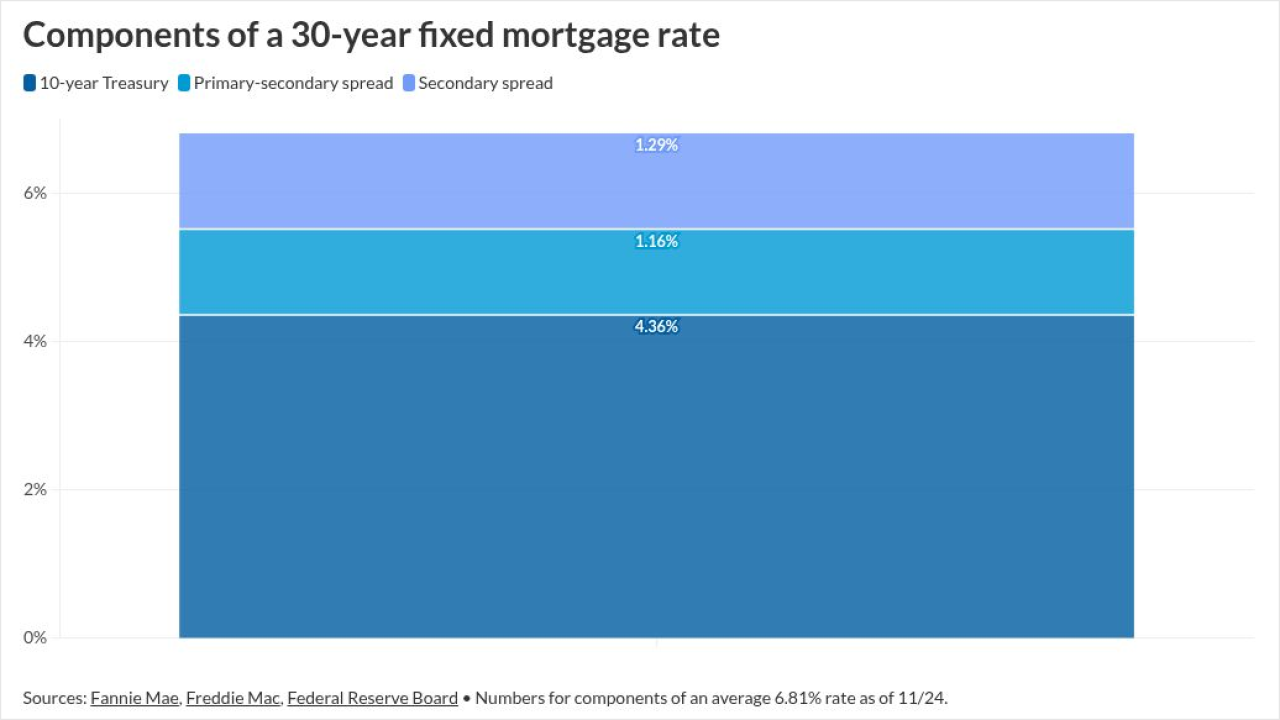Credit unions, unencumbered by a mandate to maximize profits, have generally been conservative in their approach to business.
That conservatism extends to funding, with CUs relying almost exclusively on traditional channels like deposits, Federal Home Loan Bank advances and direct sales of assets like mortgages and business loans into the secondary market.
Securitization? Not so much, and not without reason. Until a 2017 regulatory legal opinion from the National Credit Union Administration, CUs were not even permitted to pursue asset-backed securities deals. And even after the NCUA opinion, that permission went unexercised until late in 2019.
While small by ABS market standards – the pool of loans involved came to less than $200 million – the 2019 ice-breaker represented a significant shift in a category of lender that holds a major share of the auto market.
And credit unions are likely to remain a key player in autos, in no small part because of their pricing advantage. According to data from National Credit Union Administration, credit unions easily best banks at auto-loan rates: Last September, the rate on the average 60-month new-vehicle loan from a credit union was 3.63%, compared with 5.2% for banks.
All of which makes the move in November by GTE Federal Credit Union of Tampa, Fla., to opt for securitization a noteworthy moment.
The $2.2 billion asset institution – which does business as GTE Financial – placed a portion of its estimated $800 million in auto-loan assets into a newly established trust. It securitized about 9,000 new- and used-car loans with a balance of $185.27 million as collateral for a $175 million asset-backed bond sale.
The deal is viewed by market observers as potentially paving the way for more credit unions to follow suit with asset-backed securities of their own backed by auto loans.
In a Jan. 9 report, DBRS Morningstar said it “expects to see more credit unions enter the securitization market, especially if the NCUA is involved in providing explicit guidance.”
The development could also provide a new source of auto loans to help meet the high investor demand for auto ABS securities that topped $111 billion last year.
The $347.2 billion in auto loans owned by credit unions at the end of the third quarter of 2019 (representing 34% of the $1.1 trillion in outstanding loan assets on their books) represent a “sizable pool” that illustrates “the future securitization potential for the [ABS] sector,” according to DBRS Morningstar.
The first wave?
“Credit unions have a lot of loans, including indirect loans, on their balance sheets, and this may be one avenue for balance sheet management, especially if the pricing is right,” said Vincent Hui, managing director at banking consultancy Cornerstone Advisors.
In an interview, S&P Global Ratings analyst Peter Chang said the agency’s view “from a few years ago was that we may see a few new issuers like credit unions enter the market after the NCUA cleared their ability to securitize loans."
“After GTE’s last year, more credit unions may be looking to securitize during 2020,” said Chang, a director with the agency’s structured finance ratings team.
“I’m assuming this will be a catalyst for more credit union ABS deals,” said Joseph Cioffi, a partner at New York law firm Davis & Gilbert who writes a blog covering the auto and consumer-loan ABS markets. “But it will be a slow go. We could see another one or two over the next year or so.”
Stepanie Mah, a DBRS Morningstar vice president in structured finance research said the credit strength of credit union loans makes them attractive assets. According to the NCUA, the 60-plus day delinquency rates for credit union auto loans in 2019 was at 0.58%, in line with prime ABS rates of 0.45% in December, according to Kroll Bond Rating Agency.
Structured as a Rule 144A transaction via Stifel Nicolaus, the GTE Financial securitization transaction (dubbed GTE Auto Receivables Trust 2019-1) included two senior-note fixed-rate tranches with varied maturities. A $58.19 million Class A-2 offering due December 2022 priced with a coupon of 2.17%, and a $52.94 million Class A-3 tranche due August 2024) carried a 2.39% rate, according to ratings agency reports. (Both tranches were rated AAA by S&P and DBRS Morningstar.)
GTE’s bankruptcy-remote trust also sold a $36.3 million, one-year tranche of notes for money-market fund investors with a 2.053% coupon, with top short-term ratings of A-1+ by S&P and R-1(high) by DBRS Morningstar. Two subordinate tranches – sized at $22.3 million and $5.3 million – were rated single-A and BBB and priced at 2.44% and 2.79%, respectively.
Officials with GTE Financial could not be reached for comment about the transaction. A Stifel spokesman also declined to comment on the deal, nor confirm if other credit unions are working on additional auto ABS deals.

Deal genesis
The groundwork for the GTE deal was a June 2017 legal opinion from the NCUA, the federal supervisory agency and depository insurer for credit unions. That letter was in response to a question of whether federal credit unions had the authority to issue and sell securities (through asset-based securitization) under both NCUA regulations and the Federal Credit Union Act.
Although the FCUA does not authorize credit unions to engage in securitizations, the opinion letter stated federally chartered institutions have the ability to engage in activities that could fall under the “incidental powers” provisions of the act, so long as they meet a three-pronged test to meet the interests and needs of members as well as address safety and soundness concerns.
The letter, in essence, gave the nod for federally chartered CUs to proceed, but spelled out that credit unions should “work closely and diligently” with the NCUA to ensure a securitization program “is designed and implemented successfully,” according to DBRS Morningstar.
“There is no regulatory ‘pre-approval’ per se for any deal,” said Cioffi, “but the NCUA encourages credit unions to apply to the agency to do a securitization and work with them on design and implementation.”
Unique mission and structure
So why did it take nearly two and a half years after the NCUA legal opinion for the first credit union ABS deal to arrive with the GTE transaction?
Credit unions’ overall conservative approach to growth and new strategies certainly plays a part. In addition, credit unions have not traditionally explored securitization in other areas like mortgage and commercial loans, instead making direct sales to other lenders in club deals. All of which is why some remain unconvinced the tide is about to turn in a significant way.
Mike Lord, CEO of North Carolina’s State Employees’ Credit Union—the second-largest credit union in the nation, with $41.4 billion in assets and a $24.5 billion book of loans, at the end of 2019—said borrowing from the FHLB system, attracting deposits, making whole-loan sales and participating in loan pools have been more the more typical funding routes for credit unions. It’s difficult to see securitization displacing much or any of those resources, given credit unions’ conservative bent, he said.
“I don’t see a big storm brewing in terms of lots of credit unions jumping into this,” said Lord. (As a state-chartered institution, SECU is not covered by the NCUA legal opinion that applied strictly to federal credit unions.)
To what extent CU securitization will represent a regular source of auto ABS for investors remains an open question. But auto ABS notes have been in high demand in recent years, from deals backed by financially strong sponsors (both prime and subprime), and built with deep structural investor protections and rapid amortization schedules in comparison to other structured-finance asset classes.
GTE’s first collateral pool has a weighted average borrower FICO of 727, which is firmly within the tier of peer prime ABS transactions.
Unique risks
But credit union loan portfolios also carry unique risks in many aspects as ABS collateral.
For example, since credit unions operate primarily in local-only footprints, CU loan pools are highly concentrated geographically. About 98% of the loans in GTE’s collateral pool are within the Tampa area, where the firm operates 24 branches, according to presale reports.
That may be problematic for investors who want more diversity in assets. Auto ABS sponsors will typically build regionally diverse loan pools in order to mitigate the risk of having too many loans originated from one area, where too many borrowers may be subject to local economic conditions or a singular catastrophe event like a hurricane.
The loans GTE pooled into its deal also offer lower-average interest rates and more extended-term loans than what’s usually included in prime auto ABS offerings of institutions like Santander Consumer USA or automotive captive-finance lenders like Ford Motor Credit Co. and American Honda Finance.
The concentration of loans with original terms of 73 to 84 months is over 62% of the GTE 2019-1 pool – whereas many prime auto ABS pools often exclude loans over six years. (Extended-term loans have historically increased default risk in bank and finance company ABS offerings.)
GTE Financial’s credit enhancement levels are higher than other prime ABS issuers – perhaps stemming from its status as a first-time issuer as well as some of the aforementioned collateral risks.
GTE’s pool of loans has aggregate balances exceeding the note certificate obligations by 5.54%, providing an overcollateralized buffer to protect against investor losses. The Class A notes also benefit from the 14.88% subordination cushion of subordinate notes that would take first losses on any shortcoming in receivables, plus a non-declining reserve account totaling 0.25% of the initial pool balance. In contrast, American Honda Finance has the track record and stability to earn triple-A ratings with CE levels of just 2.75% for its recent vintage deals, after nearly 30 years of securitization history and negligible historical losses on $102 billion of ABS note sales.
Hurdles to more deals
DBRS Morningstar stated the advantage shown from GTE’s securitization is expanding the limited liquidity options for credit unions, which as member-owned not-for-profits are restricted from raising funds through unsecured debt financing or the equity market.
“Managing growth to date is therefore accomplished via whole loan sales and the loan participation market,” the Nov. 1 report stated. “This ABS transaction adds to [GTE’s] ability to manage its liquidity and growth.”
However, any potential ABS sponsor from the CU sector will likely need to be a relatively large credit union (GTE has over 235,000 members) with a portfolio of diverse assets, similar to GTE’s mix of auto, mortgage, home equity, consumer unsecured credit card and commercial loans. “Securitization can be expensive and needs to be cost effective for the credit union at hand, likely more advantageous for a larger sized credit union with a diverse portfolio of assets,” said Mah.
To sponsor asset-backed securities, Mah said a credit union would have to build out internal operations that could handle the proper internal oversight, controls and other safeguards to exercise appropriate due diligence on deals. Management would have to track internal risks to credit, liquidity, reputation, and the impact on the operations and strategy of the CU. A credit union would also need to invest in technology to track asset-level data for reporting purposes, and bring its board up to speed on securitization practices and policies.
Cornerstone’s Hui added that a “wild card” is regulatory scrutiny. “This is new to the credit union world and it is unclear how the NCUA would react if more folks do this, as it does change the risk profile,” he said. Larger credit unions may be “able to do something that would be attractive to the ABS market while not creating too much disruption to their balance sheets.” ASR




